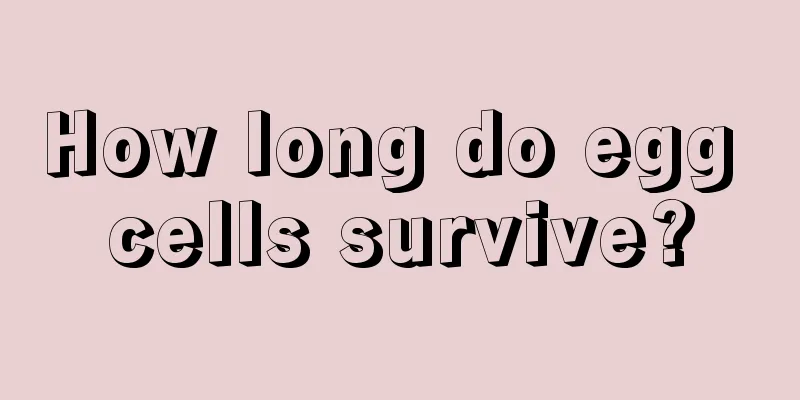How long do egg cells survive?

|
Girls ovulate regularly once a month, and the eggs released have a survival time. If there is no collision with sperm during this period to produce a fertilized egg, the egg will be lost with the body's menstrual period. Therefore, the number of eggs is limited. If you want to get pregnant, you must master the time of ovulation. Some relevant knowledge about eggs needs to be understood clearly. How long does the egg survive after it is released? How long can an egg survive after it is released? Women ovulate regularly once a month. The time of ovulation (ovulation period) is generally 12-16 days before the next menstrual period. The egg can only survive for 12-30 hours after being released. The average survival time of an egg after being released is 12-30 hours, so if you want to have a baby, the egg must quickly merge with the sperm. If the egg does meet a healthy sperm on the way to the uterus, they combine and begin to create new life. But if the egg does not meet the sperm, it will break down in the uterus, ending its journey. Because pregnancy is not occurring, the ovaries stop producing estrogen and progesterone (also known as progesterone), which help maintain pregnancy. As levels of these two hormones drop, the thickened endometrium is shed during menstruation and expelled from the body along with the dissolved egg. Minimum egg survival time The survival time of most women's eggs is 2 days, a small number is 3 days, but there are also many women whose eggs only survive 1 day. The shortest female egg survival time is even less than 12 hours. In other words, these women have only one chance to conceive during each menstrual period, which is on the day of ovulation. If the couple misses this day, they will have to wait until the next menstrual period. Women in their normal reproductive period ovulate once a month, approximately 12-16 days before the next menstrual period. The egg survives for 1 day, and the sperm can survive for 3 days after entering the female reproductive tract. Therefore, pregnancy is possible if you have sex 3 days before ovulation or 1 day after ovulation. This is called the danger period. The eggs can mature and be released at any time. Although there are 300,000 to 600,000 primordial follicles in the ovaries that can produce eggs, only 400 to 500 follicles will mature and release eggs in a lifetime. In principle, only one ovary produces one egg per month. After being released, it quickly enters the fallopian tube to prepare for fertilization. If it does not meet sperm, it will lose the ability to conceive within 12 to 24 hours. According to statistics, an average woman will ovulate more than 400 eggs in her lifetime, which means that a woman has only 400 to 500 chances of getting pregnant in her lifetime. Excluding some wasted menstrual periods, a woman's chances of ovulating and getting pregnant are less than 200 times. In addition, the best reproductive age for women is between 23 and 29 years old. During this period, if a normal woman releases 12 eggs each year, then the best chance of a woman becoming pregnant is only 84 times. |
<<: Can I sing during early pregnancy?
>>: Where is the egg fertilized
Recommend
What are the benefits of eating figs? How to store figs for a long time
Figs are a fruit with high nutritional value. The...
What to do if you bleed three days after sex
Some women experience abnormal physical phenomena...
What to eat to repair the uterus after medical abortion
Medical abortion is a relatively common method of...
What should pregnant women do if they have tinea pedis?
People don't want to suffer from diseases, bu...
White spots on chest
In life, some women will have some white spots on...
What are the effects of iron deficiency anemia in pregnant women on the fetus?
Pregnant women will be very worried if they have ...
Which parts of the body should be moxibustioned for diarrhea caused by kidney deficiency? How to treat diarrhea caused by kidney deficiency?
Acupuncture points on the back and lower limbs ar...
What to do if a woman has severe hematuria
Hematuria is caused by an abnormal increase of he...
What does a purple sweet potato look like when it's bad? Is it ok to eat a purple sweet potato with white spots inside?
Purple sweet potatoes are the same as the sweet p...
Where does pelvic inflammatory disease occur?
In real life, pelvic inflammatory disease is a ve...
If I can't detect a strong positive result, will I ovulate?
When couples are preparing for pregnancy, they pa...
Revealing the five most common causes of postmenopausal bleeding!
Generally speaking, women will no longer experien...
What to do when breasts swell and hurt
During the period of weaning, mothers will feel t...
What is "interventional therapy"? What diseases are suitable for interventional therapy?
What is "interventional therapy"? What ...
Detailed process of gynecological examination for women
Some women suspect that they have gynecological d...









